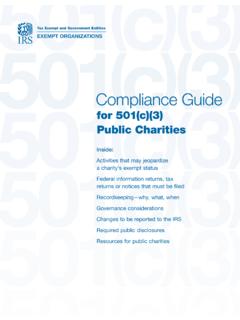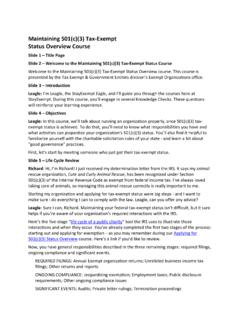Transcription of G. IRC 501(c)(7) ORGANIZATION - IRS tax forms
1 1980 EO CPE Text G. IRC 501(c)(7) ORGANIZATION . 1. Introduction Social and recreational clubs were originally granted exemption in the Revenue Act of 1916. Congress stated that the reason for their exemption was that the experience of the Treasury Department had been that securing returns from clubs had been a source of expense and annoyance and had resulted in the collection of little or no tax. By contrast, the justifications offered by Congress for the majority of other exempt classifications are that they provide some sort of community service or public benefit. Generally, social clubs are membership organizations primarily supported by funds paid by their members. The tax exemption of social clubs has the practical effect of allowing individuals to join together to provide themselves recreational or social facilities on a mutual basis, without further tax consequences, where the sources of income of the ORGANIZATION are limited to receipts from the membership.
2 Thus, the individual member is in substantially the same position as if he had spent his income on pleasure or recreation without the intervening ORGANIZATION . (Note that IRC 277 provides that a membership ORGANIZATION not exempt from tax may deduct expenses attributable to the provision of goods, services, or insurance to members only to the extent of income derived from members. In any tax year in which deductions exceed income, excess deductions are treated as paid in the following year. The purpose of this provision is to prevent nonexempt membership organizations from effectively rendering themselves free of tax by offsetting losses from membership activities against income derived from investments or other nonmember sources to produce little or no taxable income. Were they permitted to do so, they could put themselves in a better position than exempt clubs, which are taxable on all income but so-called "exempt function" income.)
3 See IRC 512(a)(3). and 277. This provision could be significant in computing the tax due from a revoked club.). 2. General Rules The ordinary meaning of the term "club" implies that there must be club members, and that there must be a "commingling" of the members for social, recreational, or similar purposes. The commingling requirement has been stated in Rev. Rul. 58-589, 1958-2 266, Rev. Rul. 70-32, 1970-1 132, and Rev. Rul. 74-30, 1974-1 137. Commingling is present if such things as meetings, gatherings and regular meeting FACILITIES ARE EVIDENT. Rev. Rul. 58-589, 1958-2 266, discusses the criteria for exemption under IRC 501(c)(7) and holds that a club must have an established membership of individuals, commingling, and fellowship to be a social club within the meaning of the statute. While this does not mean that a club cannot have artificial entities, such as corporations, as members, a federation composed completely of artificial entities (clubs) was held to be not exempt under IRC 501(c)(7) in Rev.
4 Rul. 67- 428, 1967-2 204. The rationale of that case was that a federation of clubs was a collection of artificial entities not capable of the kind of commingling required of the membership of exempt clubs. Thus, corporate memberships will not automatically disqualify a club as long as there are sufficient individual members to provide the requisite amount of fellowship and commingling. (See Rev. Rul. 74- 168, 1974-1 139). Clubs must be organized for pleasure, recreation and other non-profitable purposes. The Service has held that these other nonprofitable purposes must be similar to providing pleasure and recreation. Sponsoring activities of a noncommercial nature can lead to denial or revocation if the activities are not similar to providing pleasure and recreation. In Rev. Rul. 63-190, 1963-2 212, an ORGANIZATION was held not to qualify for exemption under IRC 501(c)(7) where it provided its members with sick and death benefits.
5 A club is not exempt if it provides pleasure and recreation on a commercial basis. Evidence that a club may be operating on a commercial basis exists if: 1. Membership requirements are broad or vaguely stated;. 2. The initiation charges or dues are so low that one-time or transient use of the facilities by the general public is encouraged;. 3. Management is strenuously engaged in expanding club membership; or 4. Management can effectively perpetuate itself through close physical and financial ties to club activities or facilities, or by other means. (See Exempt Organizations Handbook IRM 7751-124.). Reg. (c)(7)-1(b) makes it clear that making club facilities available to the public for a fee is not a permissible IRC 501(c)(7) activity, and it establishes a presumption that a club is engaging in business if the club solicits public use of its facilities. The basic problem in this area is to determine whether a substantial purpose of a purported club is to operate a commercial activity.
6 This determination will necessarily rely on an examination of all relevant facts and circumstances. 3. 94-568. The tax treatment of social clubs has undergone a substantial change due to the passage of 94-568 on October 20, 1976. Prior to passage of this law, IRC. 501(c)(7) provided exemption for clubs organized and operated exclusively for pleasure, recreation and other nonprofitable purposes. The law substitutes the word "substantially" for "exclusively". The law also added IRC 501(i) to the Code, which prohibits discrimination by certain social clubs. That section reads: (i) Prohibition of Discrimination by Certain Social Clubs. Notwithstanding subsection (a), an ORGANIZATION which is described in subsection (c)(7) shall not be exempt from taxation under subsection (a) for any taxable year if, at any time during such taxable year, the charter, bylaws, or other governing instrument, of such ORGANIZATION or any written policy statement of such ORGANIZATION contains a provision which provides for discrimination against any person on the basis of race, color or religion.
7 In addition, the law does not allow a social club exempt under IRC 501(c)(7) a corporate dividends-received deduction in computing unrelated business income tax, thus codifying longstanding service position in that regard. 4. Substitution of "Substantially All" for "Exclusively". This change is most likely to cause problems in the interpretation of the law. The existing regulations under IRC 501(c)(7) are of no use in this regard and are being revised to reflect the provisions of the law. Reg. (c)(7)-1(a) states, in part: In general, this exemption extends to social and recreation clubs which are supported solely by membership fees, dues, and assessments. However, a club otherwise entitled to exemption will not be disqualified because it raises revenue from members through the use of club facilities or in connection with club activities. The Service has attempted to clarify the kinds and degree of activities which would cause a club to lose its exemption through non-member participation in club affairs and activities (See Rev.)
8 Rul. 58-589, 1958-2 266, which stated that dealings with non-members must be incidental to and in furtherance of general club purposes and the income from that participation must not inure to the benefit of the members.) Then, in Rev. Rul. 60-324, 1960-2 173, an ORGANIZATION that derived 12 to 17 percent of its total income from the general public's use of its facilities was revoked as not being operated exclusively for pleasure, recreation or other nonprofitable purposes. Various court decisions also discussed the permissible volume of non-member income (See v. Fort Worth Club, 345. 52 (5th Cir. 1965)). In Rev. Proc. 64-36, 1964-2 962, the Service established guidelines for determining the effect on the club's exemption of gross receipts derived from non- member use of its facilities. The guidelines determined the extent to which these gross receipts would be taken into account as a factor reflecting the existence of a non-exempt purpose.
9 These guidelines were superseded by Rev. Proc. 71-17, 1971-1 683. The Service established as an audit guideline that if gross receipts derived from non-members exceeded $2,500 and were five percent or more of the total gross receipts of the ORGANIZATION a non-exempt purpose that could result in revocation was indicated. Gross receipts from non-members at or below these levels did not demonstrate a non-exempt purpose. Thus, a "safeharbor". rule was created. Even when the limits were exceeded, the Service looked at all the facts and circumstances to determine whether a non-exempt purpose existed. However, this audit standard related solely to the exempt status of a club, and had no effect on the amount subject to taxation as unrelated business income. (Income derived by a social club pursuant to a reciprocal agreement with a social club of like nature is to be treated as income from nonmembers, as the legislative history of this section indicates that it was intended that amounts derived from sources outside the membership are not entitled to the benefits of tax exemption.)
10 It should be noted that Rev. Proc. 64-36 provided that a social club would not be adversely affected by the presence of members of another social club under an agreement which provides for the reciprocal use of facilities. Rev. Proc. 71-17 did not address this issue because at the time of its publication this issue had not been resolved.). Public Law 94-568 has changed the audit standard. Since the Tax Reform Act of 1969 subjected social clubs to tax on their investment income as well as their unrelated business income, Congress felt that the percentage requirements could be liberalized as long as a club was substantially devoted to the personal, recreational or social benefit of its members. The Committee reports indicate their intent was to make it clear that social clubs may receive some outside income, including investment income, without losing their exempt status and permit them to derive a higher percentage of gross receipts from the use of their facilities and services by nonmembers than would have been permitted under published Service guidelines.













